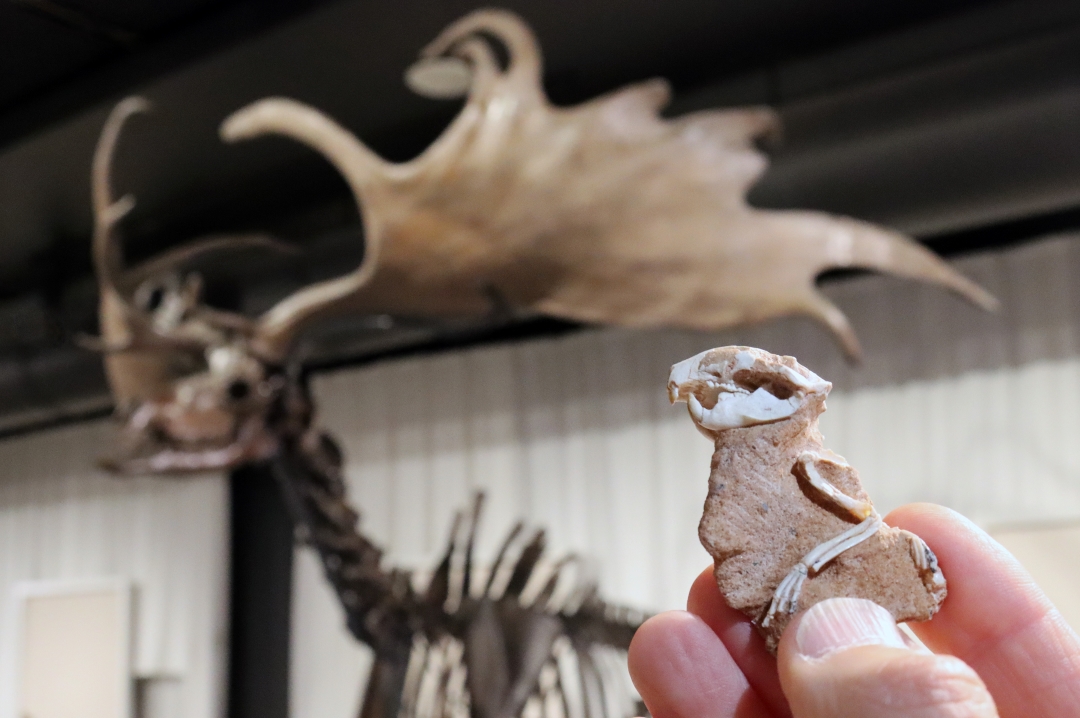The Giant History of Mammals

Mammals that lived in the shadows of dinosaurs for 150 million years - small, discreet, and hidden like Kryptobaatar* - saw their size and number of species increase following the extinction of these giant reptiles 66 million years ago. It was the beginning of what is known as the Age of Mammals. It follows the Age of Dinosaurs.
The conquest of ecological niches left available by the extinct dinosaurs has yet to be completely understood.
We know that during the first ten million years (Paleocene: 66-56 million years ago), the surviving species grew larger. After 400,000 years, some placental mammals (those giving birth to well-developed young after a long gestation) reached 50 kg, and the first large herbivorous mammals appeared after a few million years. They were the pantodonts. By the end of the Paleocene, some had exceeded 500 kg (Barylambda). Some predators reached the size of a dog among the mesonychids (Ankalagon)
Other animal groups followed suit. Non-flying birds over 2 meters tall appeared, resembling carnivorous dinosaurs, but they were... herbivores (Gastornis). When the large marine reptiles disappeared along with the dinosaurs, sharks also grew larger, particularly the otodontids, ancestors of the Megalodon. Perhaps the most remarkable growth occurred among snakes, with record dimensions reached by Titanoboa, a boid of 13 meters long and a weight of about a ton.
Modern Mammals
But it was not until the dawn of the Eocene, 56 million years ago, during an extremely rapid and intense global warming event known as the PETM (Paleocene-Eocene Thermal Maximum), that the diversity of mammals truly exploded. New groups of placental mammals suddenly appeared on the three continents of the northern hemisphere, thanks to intercontinental land bridges that allowed them to disperse widely.
These new groups, referred to as "modern mammals," with brains proportionally larger than the "archaic mammals" of the Paleocene, include perissodactyls, artiodactyls, cetaceans, carnivores, bats, primates, rodents, and lagomorphs.
Although these eight groups represent 83% of the current diversity of mammal species, their ancestors are still relatively unknown. A very fine extract in Science et Vie from May 2023 (no. 1268) pays tribute to these mammals who conquered the world.
In each of these groups, new giants emerged, result of a generally slow evolution, driven by incessant competition, climatic upheavals, and sometimes extreme dietary and anatomical specializations.
Among the perissodactyls (the group that includes modern horses, rhinoceroses, and tapirs), this evolution produced the largest land mammal, Paraceratherium. The evolutionary history of the artiodactyls recalls the giant deer (Megaloceros) with its 3-meter-wide antlers, and the cetaceans certainly include Basilosaurus and Livyatan* among the giant toothed whales (Odontocetes), and of course the blue whale (Mysticete). Even the primates, to which we belong, had their giant : the Gigantopithecus*, a 3-meter-tall orangutan. Some rodents (the group that includes squirrels and marmots) reached a ton in weight. But the most impressive was undoubtedly Smilodon* populator, a feline with an estimated weight of 400 kilograms and whith canines of nearly 30 cm long. And let’s not forget the mammoths* and giant sloths (Megatherium*) of the Ice Age.
Fragile Giants
But giants are colosses with feet of clay, and the majority of them have already disappeared. However, a few still survive in our beautiful biodiversity: the elephant, the gorilla, the rhinoceros, the blue whale... They may seem indestructible due to their size and strength, but in reality, they are extremely fragile. As with the giants of the past, just a few changes in their habitat, food resources, or climate can lead to them disappearing as well. It is therefore not surprising that the most endangered species in the world include many giants such as the Sumatran elephant and rhinoceros, the whale shark, the Bornean orangutan, the African forest elephant, the eastern lowland gorilla of Congo, and the Sunda tiger of Indonesia. The cause of this new extinction, unfortunately, seems to be another giant: man!
*Animals featured in the GIANTS exhibition.
GIANTS
A journey through time to meet 11 gigantic animals that lived after the dinosaurs. An ENOURMOUS chance to feel small as can be next to these live-sized giants!
